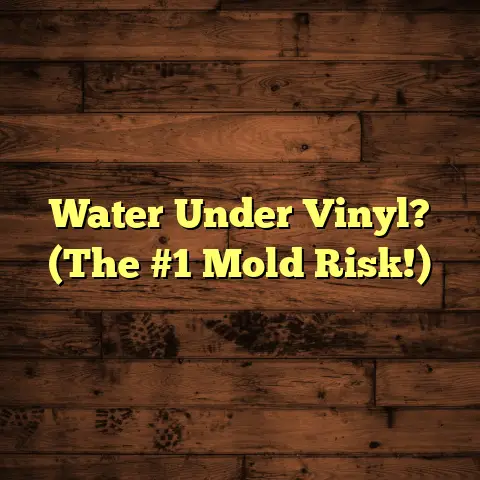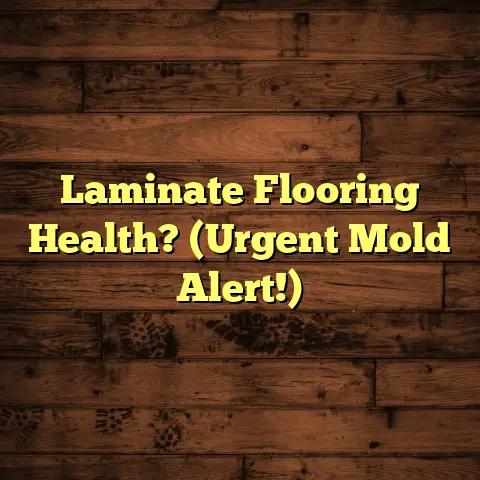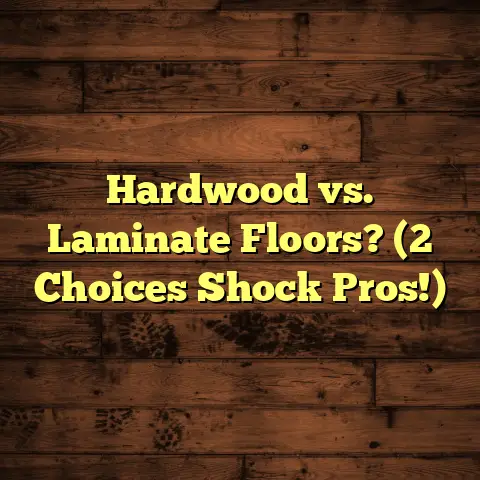Flooring Staples Vs Cleats? (Explained)
When I think about creating a warm and inviting space in a home, flooring is often the unsung hero.
The right floor can transform a room, making it feel cozy and welcoming.
However, choosing the right flooring materials and installation methods can be quite a journey.
Recently, I found myself weighing the merits of flooring staples versus cleats in my projects, and I’d love to share my insights from that experience.
The Basics: Staples vs. Cleats
In my many years of working in the flooring industry, I’ve encountered various installation methods.
Two of the most common fastening options for hardwood and engineered wood floors are staples and cleats.
Each has its unique advantages and challenges.
Flooring Staples
Staples are generally shorter and have a flat head, which allows them to be driven into the subfloor at an angle.
This design provides a strong hold that works well for various flooring types.
Experience with Staples:
I remember a project in a cozy bungalow where we used staples to install engineered hardwood flooring.
The homeowners wanted a quick turnaround, so we opted for staples due to their ease of installation.
The process was smooth, and we finished installing the flooring in just two days.
The staples held the flooring securely, providing a solid feel underfoot.
Challenges with Staples:
However, I did encounter some challenges.
In certain instances, particularly with thinner flooring materials, staples could create visible dimples if not installed correctly.
It’s crucial to ensure the proper depth when using staples to avoid this issue.
Flooring Cleats
Cleats, on the other hand, are longer and have a round head.
They are typically driven into the subfloor using a flooring nailer, which makes them more suitable for thicker wood floors.
Experience with Cleats:
I once tackled a large commercial project where we decided to go with cleats for solid hardwood flooring.
Given the thickness of the planks, cleats provided the necessary grip.
The installation was a bit more labor-intensive, but the durability and stability they offered were worth it.
As a bonus, it allowed for better expansion and contraction during temperature changes.
Challenges with Cleats:
One downside I noticed is that while cleats provide excellent holding power, they can make future removal of the flooring more complicated.
If clients ever decide to change their flooring again, they might face some difficulties in extraction due to the secure hold of cleats.
Comparing Costs and Efficiency
When it comes to cost estimation, I rely heavily on tools like FloorTally.
It streamlines my calculations and helps me provide clients with accurate budgets based on material and labor rates in our area.
Cost Insights:
For instance, in that bungalow project with staples, I estimated around $2.50 per square foot for materials and an additional $1.50 for installation.
On the other hand, the commercial project using cleats came out to about $3.00 per square foot for materials with an installation cost of $2.00 per square foot due to the extra labor involved.
Using FloorTally allowed me to present these estimates transparently to my clients, which they appreciated.
Having everything organized in one place also saved me time during project planning.
Practical Considerations: Installation Techniques
Installation with Staples
When installing with staples, I usually recommend using a pneumatic staple gun.
It ensures that each staple is driven in at the correct angle and depth.
Here’s a quick step-by-step:
- Prepare the Subfloor: Make sure it’s dry and clean.
- Lay Out Your Boards: Start along one wall, leaving space for expansion.
- Staple at the Tongue: Drive staples into the tongue of each board at 6-8 inch intervals.
- Check Alignment: Ensure everything remains straight as you work.
Installation with Cleats
For cleats, I prefer a flooring nailer as it makes the process much easier:
- Prepare the Subfloor: Similar to using staples, ensure it’s ready.
- Start Along the Wall: Lay down your first row similarly.
- Nail at an Angle: Position your nailer to drive cleats into the tongue of each board at 6-8 inch intervals.
- Check Stability: After nailing, check that each board is secure.
Maintenance Tips
Regardless of whether you choose staples or cleats, proper maintenance of your flooring is essential for longevity.
- Regular Cleaning: Sweep or vacuum regularly to avoid dirt accumulation.
- Humidity Control: Keep humidity levels consistent to prevent warping or buckling.
- Inspect for Issues: Periodically check for any loose boards or squeaks and address them promptly.
Personal Insights and Recommendations
After years in this industry, my preference often leans toward cleats for solid hardwood installations because of their durability and secure hold.
However, for quick projects or thinner materials, staples can be incredibly effective.
Tips for Making Your Choice
- Consider Flooring Thickness: If your flooring is thin, staples might be more suitable.
- Evaluate Future Plans: Think about whether you might want to replace or remove the flooring in the future.
- Assess Budget Constraints: Weigh your budget against the costs associated with both methods.
The Emotional Aspect of Flooring Choices
Choosing flooring isn’t just about material; it also involves emotional connections and personal preferences.
I’ve had clients who walked into a showroom and immediately gravitated toward specific colors or textures because they reminded them of their childhood homes or favorite vacations.
One memorable client was an elderly woman who wanted to recreate her grandmother’s kitchen floor—an old oak that had been worn but was full of character.
We used cleats for this project because of the thickness of the reclaimed wood she chose.
It made her emotional connection even stronger because we were able to replicate that beloved space accurately.
The Importance of Quality Materials
Whether you choose staples or cleats, selecting high-quality materials is paramount.
I’ve seen firsthand how inferior products can lead to long-term issues like warping or unstable flooring.
Choosing Quality Brands
Investing in reputable brands can save you money in the long run by reducing maintenance costs and extending the lifespan of your floors.
For instance:
- Adhesives: Always use high-quality adhesives designed specifically for wood flooring installations.
- Underlayment: Choosing a good underlayment can significantly enhance sound dampening and comfort.
- Wood: Ensure the wood you select is properly dried and sourced from reliable suppliers.
Tools of the Trade
Having the right tools makes all the difference when installing floors.
Over time, I’ve gathered an arsenal that aids in both efficiency and quality results:
- Pneumatic Stapler: Essential for quick installations with staples.
- Flooring Nailer: For driving in cleats effectively.
- Moisture Meter: Helps confirm that the subfloor is dry enough before installation.
- Laser Level: Ensures everything is aligned perfectly from start to finish.
Troubleshooting Common Issues
Even with careful planning and execution, problems can arise during installations.
Here are some common issues I’ve encountered and how I’ve dealt with them:
Cupping and Crowning
Cupping occurs when the edges of planks are higher than the center, while crowning is when the center is higher than the edges.
These issues often arise due to humidity changes.
Solution: In projects where this has occurred, I’ve recommended proper acclimatization of the wood before installation, allowing it to adjust to room conditions.
Squeaky Floors
Squeaks can be frustrating for homeowners.
They often result from movement between boards or inadequate fastening during installation.
Solution: Addressing squeaks requires identifying where they’re coming from—sometimes it’s as simple as tightening a few fasteners or re-nailing boards in problematic areas.
Long-Term Care Strategies
While installation techniques are vital, long-term care strategies will prolong the life of your flooring:
Regular Maintenance Schedule
I always advise clients to set up a maintenance schedule that includes:
- Monthly cleaning with appropriate products
- Annual deep cleaning
- Professional inspections every few years
Addressing Damage Promptly
If damage occurs—be it scratches or water damage—addressing it quickly can prevent more extensive repairs later on.
- Scratches: Use wood fillers or markers that match your floor color.
- Water Damage: Dry out any affected areas immediately and assess if boards need replacement.
Sustainability Considerations
Sustainability is becoming increasingly important in our industry as clients seek eco-friendly options.
Choosing sustainable materials not only benefits the environment but can also enhance your brand’s reputation as a contractor.
Sourcing Materials Responsibly
When selecting materials, I often look for options that come from sustainable forests or manufacturers committed to environmentally friendly practices.
Eco-Friendly Installation Practices
Implementing eco-friendly practices during installation can also make a positive impact:
- Use low-VOC adhesives
- Minimize waste by planning cuts carefully
- Recycle old materials whenever possible
Engaging Clients in Decision-Making
One aspect I enjoy most about my job is involving clients in every step of their flooring decisions.
It’s not just about putting down floors; it’s about creating spaces they love.
Listening to Their Needs
Listening actively to clients’ wants helps build trust and ensures their vision aligns with what I deliver.
For example, during one project, a client was adamant about using reclaimed wood because of its history—this led us to explore local sources where we could find beautiful options that suited their budget.
Offering Visualizations
I’ve also started using software tools that allow clients to visualize how different materials will look in their space before we even begin installation.
This proactive approach has led to happier clients because they feel more involved in the process.
Final Thoughts on Staples vs Cleats
Choosing between staples and cleats comes down to your specific project requirements and personal preferences.
Each method has its strengths and weaknesses, but understanding them will help you make an informed decision that suits your needs.
Whether you’re installing flooring in a cozy home or a bustling commercial space, the right choice can make all the difference in achieving warmth and comfort underfoot.
What has been your experience with staples or cleats?
Have you faced any challenges that you’d like to share?
Your insights could provide valuable learning opportunities for others in our community!





